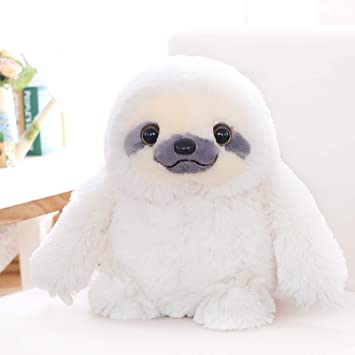The Ghost Sloth
In both the arctic and in the jungle, there are few dangers more cute and yet more dangerous than the ghost sloth. Dropping onto unwary travelers form the trees above, or exploding from a seemingly ordinary hump of snow, ghost sloths attack swiftly to kill and then devour their prey. They attack first with their poison claws, then will try to bite their disoriented opponent on or near the neck in an attempt to break the spine and then kill the prey.
Hiding behind or within solid walls do not deter the ghost sloth; they simply pass through such barriers like they were incorporeal undead like they were named after. Only if seriously hurt will they retreat, often sinking into the ground and vanishing like a terrible nightmare one has awakened from.
Basic Information
Anatomy
The Ghost sloth has four limbs - two arms and two legs. It has a heavy coat of white fur, and an undercoat of gray fur that is often brindled or spotted with darker hairs, like brown or black. Its arms end in three toes with sharp claws. The claws possess a natural poison that when it enters the bloodstream of other mammals, causes dizziness and loss of balance. The Ghost Sloth possesses two enlarged canine teeth in their mouths.
Biological Traits
Both breed of ghost sloth use camouflage to hide from predators and sneak up on prey. The arctic sloth's fur is a deep white, allowing them to hide in snow drifts while waiting for prey to approach them. The jungle ghost sloth fur hosts symbiotic algae, which provides camouflage against other predators and prey. Jungle sloths hang from trees waiting for prey to walk beneath them, permitting them to ambush their prey.
Ghost sloths do not get their name from their camouflage abilities, though, but from a magical ability they can use innately. Ghost sloths can pass through solid matter, both to attack their prey or to escape from larger predators
Ecology and Habitats
Ghost sloths are found in environmental extremes. One subspecies of ghost sloth are found in arctic climates. The more common breed of ghost sloths are found in temperate to tropical jungles. Ghost sloths are often found in or near the ruins of lost civilizations, lending credence to the theory they are not a natural animal, but a creature created by ancient magicians.
Dietary Needs and Habits
Ghost sloths are omnivorous, but prefer meat over plants. Ghost sloths are ambush predators, waiting for their prey to approach them before attacking. The animal gets its name from the length of time they can remain completely motionless while waiting for prey to approach. However, when they strike or attacking, ghost sloths can move as swiftly as most predator mammals.
Ghost sloths have the slowest metabolic rates of any mammal known, and thus only need to feed once or twice a week. Some sloths have been reported to live nearly a month in between feedings, but that is believed to be unhealthy and only in times of extreme food scarcity.
Additional Information
Social Structure
Ghost sloths are most often found in families consisting of a mated male and female and their cubs. When the cubs mature into adulthood, they will wander off and either seek a mate or hunt solo. Ghost sloths mate for life, and remain fertile the remainder of their lives.
When game is scarce, ghost sloths may form larger social groups, similar to a pack. In such groups, the strongest adult female controls the pack, followed by the other adult females. When hunting, such groups will feed cubs first, females next, and adult males last.
Domestication
Ghost sloths have never been domesticated. They are considered too violent and dangerous to be tamed by any civilized species. All attempts to befriend or tame these creatures has ended in failure and often in violence. The best civilized people can hope for is that the ghost sloths will ignore them.
Uses, Products & Exploitation
Ghost sloths are hunted for their fur, which is thick and lustrous. Wizards and sages pay dearly for ghost sloth hearts and other organs, as they may contain magical properties. Despite their extreme fierceness, many people find them to be cute. Stuffed fake ghost sloth cubs are frequently given to children as toys in certain parts of the world.
Average Intelligence
Ghost sloths are ambush predators and have an average animal intelligence. They can be social animals, acting in small packs, although this is considered rare and usually only when game is scarce. Ghost sloths are not tool users.
Perception and Sensory Capabilities
While Ghost Sloths have color vision, they have poor visual acuity. They also have poor hearing. Thus, they rely on their sense of smell and touch to find food.
Lifespan
40 years
Average Height
5 to 6 feet at full growth.
Average Weight
176 to 320 lbs.
- Natural Camouflage: Ghost sloths gain advantage when hiding from predators or prey.
- Poison Claws: Injuries made with a ghost sloth's claws require a Test against poison. Failure causes dizziness, which will require a character to make all attacks and agility checks at Disadvantage until either healed or the character rests.
- Ghostly Movement: as a standard action, a ghost sloth can become intangible and move through solid objects. While intangible, the ghost sloth cannot affect others. It takes a standard action for the ghost sloth to become tangible again.


Comments